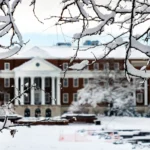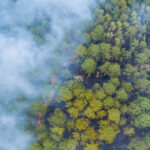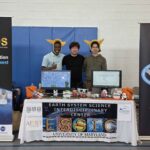By Teri West
About three years ago, ESSIC research scientist William Lau sketched a diagram in his office for doctorate student Cheng Yuan. The whiteboard drawing depicted his hypothesis about how monsoon forces could pump aerosols — tiny particles in the air — higher into the atmosphere than where airplanes fly.
With the diagram’s original arrows and squiggles still intact on the whiteboard, Lau and Yuan now have a published piece that both confirms the hypothesis and transforms knowledge about the presence of aerosols at such heights.
In 2011, scientists discovered an area over Asia where aerosols were traveling about 15 kilometers up — much higher into the atmosphere than they had thought. Lau said scientists believed that the particles moved there passively after events such as volcanic eruptions. Contrary to this prior belief, Lau has discovered a yearly occurring mechanism through which the aerosols reach those heights through natural meteorological patterns.
Globally, only a relatively small percentage of all aerosols is man-made and takes the form of smog and similar unnatural pollutants. A much larger fraction of ambient aerosols is derived from natural sources such as desert sand, wildfires, sea spray and volcanic eruptions. It is common knowledge that aerosol can form clouds and reflect or absorb solar radiation, giving it the potential to modulate Earth’s temperature.
“The impact of aerosol is far more profound than we would have guessed,” Lau said. “It’s not just human health, and it’s not just being passively blown by the wind. It might actually play an active role in modulating [climate change].”
Lau calls his mechanism of aerosols entering to high elevation a “double chimney” in reference to a specific large-scale air circulation pattern over the Asian monsoon and Middle East desert region. During India’s monsoon season, strong monsoon winds travel inland until they hit the steep wall of the southern slopes of the Tibetan Plateau, initiating deep convection that lofts the aerosols up 10 to 15 kilometers. The same process occurs on the Chinese side of the Tibetan Plateau, which creates the second vertical chimney. Once in the upper troposphere, the air is trapped in a large-scale wind circulation known as the Tibetan Anticyclone, which spans from deserts in the Middle East to the Asian continent.
Scientists who hypothesized that volcanic eruptions caused the aerosol transport into the stratosphere were perplexed by how heavy monsoon did not wash the aerosols out. In his study, Lau found that wash-out does occur but mostly for aerosols in and below clouds, cleaning out air in the lower troposphere. The aerosols transported to the upper troposphere are only released when the anticyclone dissipates at the end of the boreal summer. From there, they are spread globally throughout the stratosphere.
“Every year you have a process in which surface pollutants from a hugely polluted region go up there and spread throughout much of the lower stratosphere and even higher up,” Lau said. “Even the upper troposphere and the stratosphere is not that clean anymore.”
Lau has studied the weather and climate variability of monsoons for more than 30 years. At a conference about two years ago, he mingled with atmospheric chemists and grew interested in the presence of aerosols in the upper troposphere and stratosphere.
Yuan, who was spending two years at the University of Maryland as a visiting scholar from China, had studied atmospheric chemistry and aerosols.
After Lau's initial hypothesis, the pair looked at mixed observations and model generated outputs for 2008. Yuan is now digging into data from 2000 to 2015 to analyze variability and possible long-term change signals associated with the “double chimney” mechanism.
Lau posits that the mechanism he discovered could probably apply to other regions with similar climate conditions, particularly mountainous regions such as the Southwestern U.S. He wants the mechanism to eventually be included in climate models, and says his discovery calls for more independent observational work.
"It is exciting,” Lau said. “I mean, that’s what we look for in our science is to really discover new stuff. We have a hunch.”
He looked over at the drawing on his wall.
“I drew this map like three years ago and talked to my student…and said, ‘let’s look into this,” he laughed. “It’s an idea, which followed from my previous work, and when we dig into the data, we actually find, ‘oh, this actually seems to work.’”





